Exploring the Allure of Teal Sapphires
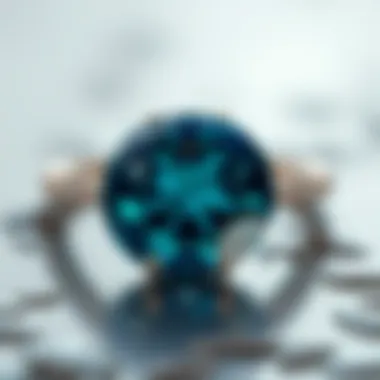

Intro
Teal sapphires, with their mesmerizing blend of blue and green, are a true treasure in the realm of gemstones. Often overlooked, these stones embody a unique character that distinguishes them from their more popular counterparts like traditional blue sapphires or emeralds. This article offers a detailed dive into the enigmatic world of teal sapphires, exploring their formation, traits, and their growing significance in both modern jewelry and the collectibles market.
Teal sapphires aren't just pretty to look at; they possess a depth that speaks to their geological journey. From the depths of the earth where they formed over millennia to their current roles adorning fine jewelry and artistic creations, they have a story worth telling. The allure of teal sapphires lies in their versatility—suitable for both everyday wear and lavish occasions, they are truly gems that can fit any hand.
As we delve deeper, we will touch on their rich history, their formation process, and how they are classified among other gemstones. Moreover, we will cover the vital aspects of sourcing, evaluating, and caring for teal sapphires, aimed at equipping collectors and jewelry makers with the knowledge handy for appreciating and maintaining these stunning gems. The beauty of teal sapphires is not just skin deep; it invites us to explore its artistry and science, promising to enrich both personal collections and contemporary design portfolios.
The Unique Characteristics of Teal Sapphire
Teal sapphires possess a blend of beauty and rarity that sets them apart from other gemstones. Their unique color variations and shimmering clarity make them highly sought after by collectors and jewelry designers alike. Understanding these characteristics is crucial for anyone interested in the world of gemstones. They not only influence the overall aesthetic appeal but also determine the value and desirability of teal sapphires in the market.
Color Variations
Color is key in defining a teal sapphire's identity. Unlike ordinary blue sapphires, these stones showcase a bold teal hue, which can range from serene blue-green to a more vibrant greenish-blue shade. This spectrum of color is influenced by various factors, including the presence of trace elements like iron and titanium during their formation. Additionally, natural light exposure can change how colors appear, sometimes shifting them slightly based on viewing angles.
Each variation adds a distinct character to the stone. For instance, a deep teal sapphire might evoke thoughts of tropical waters, while a lighter hue could remind one of soft summer skies. Collectors often seek out these different shades because they can convey unique emotions and aesthetics, increasing their appeal.
Clarity and Cut
Clarity plays a pivotal role in the visual appeal of teal sapphires. A gem's clarity is assessed by its internal inclusions or blemishes, which can affect light dispersion. Ideally, a higher clarity grade leads to a more captivating sparkle. However, even stones with slight inclusions can maintain their beauty, especially if these imperfections are strategically placed and do not obstruct the light flow.
The cut of a teal sapphire also greatly impacts its brilliance and how the color is perceived. Common cuts, such as oval or cushion, can maximize the stone's reflective qualities. An expertly cut teal sapphire can dance with light and produce a mesmerizing visual effect. Jewelers often choose specific cuts based on the sapphire’s coloration to enhance its natural beauty.
Size Considerations
When it comes to teal sapphires, size does matter. Larger stones are inherently rarer and can be more valuable. They often hold more allure, particularly when showcased in statement jewelry pieces like rings or pendants.
However, smaller sapphires have their own charm, often used in intricate designs or as accent stones in multi-gem jewelry. The versatility of teal sapphires means they can fit various style preferences and occasions. Whether one prefers the bold statement of a large piece or the delicate elegance of smaller ones, there's a teal sapphire to suit diverse tastes.
"In the realm of gemstones, each teal sapphire tells its own story through color, clarity, and size, making them truly unique in every form."
Understanding these characteristics allows enthusiasts to appreciate teal sapphires on a deeper level. It not only informs purchasing decisions but also enhances the overall experience of jewelry design and collection.
Geological Formation of Teal Sapphires
Understanding the geological formation of teal sapphires is akin to piecing together a jigsaw puzzle, where every fragment tells a story about the earth’s ancient processes. This section is crucial, not only for gem enthusiasts but also for collectors and jewelry designers aiming to grasp the essence of what makes teal sapphires so unique. The mineral composition and the geographical origins directly impact both the beauty and value of these gemstones. This exploration serves to augment one's appreciation for the teal sapphire, linking it intimately to the forces of nature that birthed it.
Origin and Mineral Composition
Teal sapphires are essentially corundum, a crystalline form of aluminum oxide, where trace elements play a significant role in their distinct coloration. The blue-green allure of teal sapphires can be attributed primarily to the presence of iron and titanium within their structure. This playful interaction of elements doesn’t just create a feast for the eyes; it also defines durability and brilliance, making these stones particularly desirable.
When examining the composition closely, one starts to appreciate the fine line between mere beauty and geological significance. The clarity and color saturation found in these stones can fluctuate dramatically based on their mineral makeup. Consequently, a thorough understanding of the mineral elements enriches the overall knowledge about these sapphires, illustrating the inherent link between a gemstone’s formation and its ultimate visual impact.
Global Sources
As with many natural resources, the origin of teal sapphires spans several key geographic locations, each contributing its unique attribute to the name. Below are the most notable sources:
Australia
Australia has put its mark on the global sapphire market for a good reason. The country is famed for producing some strikingly beautiful teal sapphires, particularly from regions like Queensland. A telling feature of these stones is their dark, intense color, often sought after by collectors looking for a deep hue that stands out.
This Australian charm isn't solely about color; it’s also about size. Many sapphires mined here often come in larger carats compared to other regions. The availability of larger stones can add significant value, especially in the crafting of statement pieces. However, potential buyers must remain vigilant as the fat greater size can mean more inclusions.
Sri Lanka
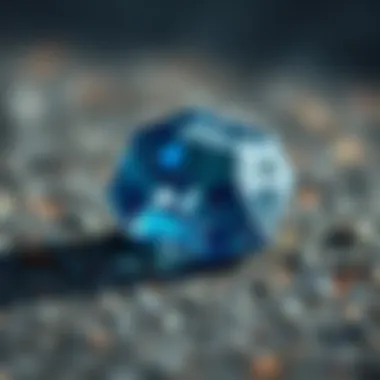
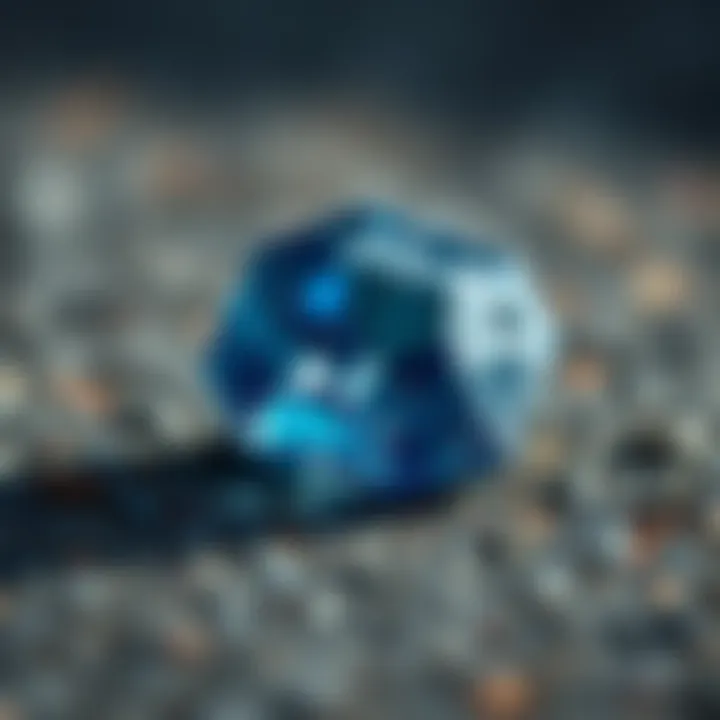
Sri Lanka is often referred to as the 'Island of Gems,' and for good reason. The sapphires from this region frequently boast a vibrant clarity that is simply hard to match. The teal sapphires found here tend to strike a balance between color and transparency, making them versatile for various jewelry designs.
A unique feature is how these sapphires can shift hues depending on the lighting. Such changeability adds to their allure, drawing in jewelers and collectors alike who appreciate not only the stone but the play of light upon it. However, this global gem hotspot faces challenges with mining regulations, making sourcing tricky and sometimes costly. This adds an extra layer to its value, as ethically-sourced stones are increasingly in demand.
Vietnam
Vietnam is relatively new in the arena of teal sapphire production, but the stones coming out of the country are quite impressive. Known for their striking clarity and vibrant colors, Vietnamese sapphires have garnered attention in both local and international markets. A remarkable aspect of these gems is their affordability compared to their Australian counterparts, allowing a broader audience to indulge in their beauty.
One distinctive feature of Vietnamese teal sapphires is their often lighter tones, enhancing their appeal for those who favor subtler jewelry designs. However, the emerging nature of this market brings a trade-off—prospective buyers should be cautious as the newer mining practices may lead to higher inconsistencies in quality.
In summary, the geological formation and sourcing of teal sapphires paint a rich picture grounded in natural beauty and historical significance. The allure of these gems is not merely skin-deep, with their origins woven intricately into the earth’s very fabric.
Historical Significance of Teal Sapphire
Teal sapphires are not just visually stunning, but they also carry a rich tapestry of historical significance. As these vibrant gemstones have garnered attention over centuries, they’ve earned their place among the treasured possessions of various cultures. This section will explore the multifaceted roles that teal sapphires played throughout history, showcasing their importance not only as decorative items but also as symbols of power, wisdom, and more.
Cultural Contexts
Symbolism in Various Cultures
The symbolism attached to teal sapphires can vary immensely across geographical and cultural lines. In many traditions, this stone is associated with tranquility and healing. For instance, in ancient Asian practices, it was believed that teal sapphires could bring peace to the mind and spirit, providing a sense of clarity during turbulent times. This characteristic makes teal sapphires a sought-after choice for those looking to find balance in their lives or enhance their personal growth.
This symbolism is unique because it doesn’t just represent a singular notion. Instead, cultures interpret the meaning of teal sapphires through their historical beliefs and customs, adding layers to its allure. The stone is often considered a harbinger of good fortune and success in endeavors, which underscores its position in various religious and artistic expressions.
"The teal sapphire stands as a beacon of tranquility, echoing ancient wisdom that connects us to the earth's cycles and energies."
Use in Royal Jewels
Teal sapphires have also found their way into royal collections, thus enhancing their historical significance. Royalty throughout history has adorned themselves with these gemstones as symbols of authority and prestige. Notable examples include the crowns and regalia of South East Asian monarchs, where sapphires symbolize divine favor.
The unique feature of these royal jewels is not just in their beauty, but also the stories they tell. They often serve as a testament to the wealth and influence of a kingdom, as well as the craftsmanship involved in their creation. Using teal sapphires in regalia elevates the stones from mere decorative items to emblematic declarations of power.
Notable Historical Pieces
The allure of teal sapphires can be seen in several notable historical pieces. One such jewel is the Teal Sapphire Necklace of the Burmese Queen, which showcases the deep connection between royalty and the gemstone. Crafted with meticulous attention to detail, it combines the beauty of these fine sapphires with intricate metalsmithing, capturing the essence of an era long past.
In addition to such masterpieces, various artifacts unearthed from archaeological sites reveal that these sapphires were highly valued in antiquity, suggesting that their significance stretches back even further than recorded history. The discovery of such items continues to provide valuable insight into the ancient societies that cherished them.
By examining these various historical pieces, one can grasp the profound impact that teal sapphires have had, influencing not just personal adornments but entire cultural narratives across generations.
Value and Pricing of Teal Sapphires
Understanding the value and pricing of teal sapphires is paramount for collectors and enthusiasts alike. As with any gemstone, the price of teal sapphires can fluctuate based on a mix of factors including their quality, demand, and market trends. This knowledge not only helps buyers make informed decisions but also enhances their appreciation for these distinct gemstones.
Market Trends
In recent years, the teal sapphire market has displayed intriguing shifts. These gems, often overshadowed by their more traditional counterparts like blue sapphires, are gaining traction due to their unique color and rarity. As consumers become more environmentally conscious, many are seeking ethically sourced gemstones. This trend is compelling, as it ties to a broader movement towards sustainability in the jewelry industry.
"Teal sapphires are rapidly becoming a preferred choice as more individuals prioritize uniqueness alongside ethical concerns in their gemstone purchases."
The rise of social media also plays a notable role in shaping market trends. Platforms like Instagram and Pinterest allow for wider visibility of teal sapphires, sparking interest and accessibility. Thus, what was once a rare choice is now becoming a favored selection among discerning buyers.
Factors Influencing Price
Quality Assessment
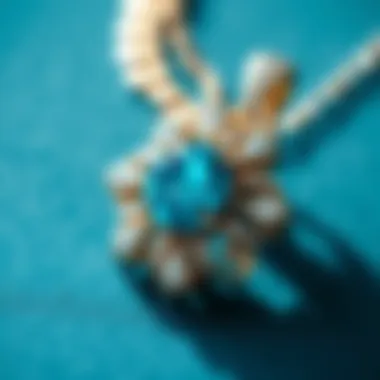
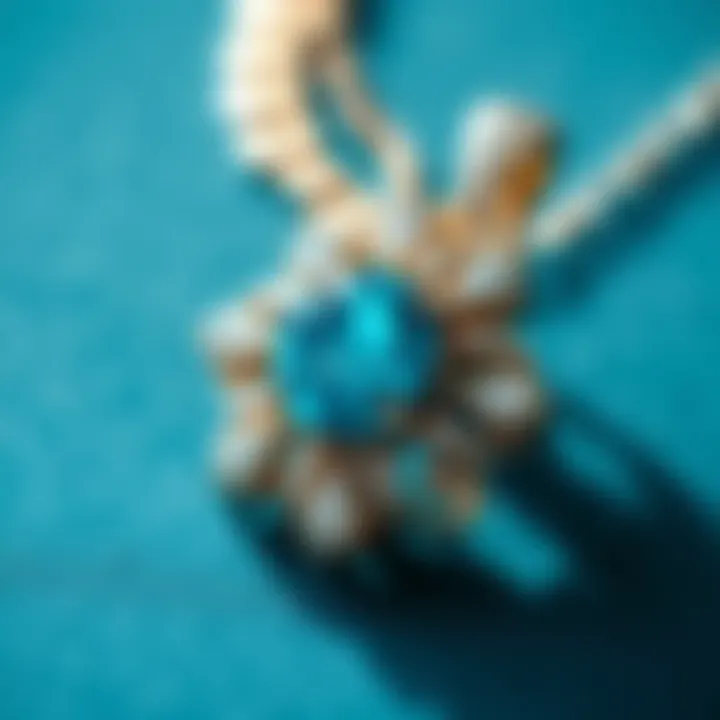
The quality assessment of teal sapphires is a critical factor in determining their price. Key characteristics include color, clarity, cut, and carat weight. Each of these aspects contributes substantially to the overall value. For instance, a deeper, more vibrant teal hue often commands high prices, while lighter shades may be less sought after. Clarity, or the absence of internal flaws, also affects pricing significantly. A teal sapphire that is clean and radiant will naturally be more valuable than one with visible inclusions.
Assessing these factors requires a trained eye, making it a popular choice for seasoned collectors. An expert appraisal ensures that buyers are well-informed before making a purchase, thus safeguarding against overpaying for subpar gemstones.
Certification Standards
Next, we have certification standards, which serve as a benchmark for quality assurance in the gemstone industry. Documents from noted gemological laboratories, such as the Gemological Institute of America (GIA), provide vital information about a gem's characteristics and synthetic or natural origins. Buying a teal sapphire that comes with certification ensures that you’re investing in a genuine stone.
While certification may add an extra cost to the purchase, it enhances the long-term value of the gemstone. A certified teal sapphire can command a higher resale price, making it a beneficial and popular choice for those viewing it as an investment.
Market Demand
Lastly, the market demand significantly influences price fluctuations. The increasing interest in teal sapphires, fueled by changing consumer preferences and greater awareness, has put upward pressure on prices. As more jewelers incorporate these stones into popular designs, demand rises, contributing to a robust market.
The unique feature of teal sapphires lies in their versatility. They suit various styles, from engagement rings to statement pieces, allowing jewelers to meet diverse tastes. However, when demand outstrips supply, prices can soar.
Ultimately, understanding these factors is crucial for anyone trying to navigate the teal sapphire market. Those who invest time in learning the intricacies of these gems will find themselves better equipped to make informed choices that align with both their aesthetic desires and financial considerations.
Teal Sapphire in Jewelry Design
Teal sapphires are gaining traction in the jewelry design world, thanks to their captivating hues that blend blue and green. These gemstones stand out not only for their stunning aesthetics but also for the meaning they carry. In the realm of jewelry, teal sapphires offer a fresh twist on classic designs and allow artisans to experiment with color while making a statement. Choosing to incorporate teal sapphires in jewelry can transform a traditional piece into something unique, modern, and visually engaging.
Popular Jewelry Styles
Engagement Rings
Teal sapphires have carved out a niche in the engagement ring market. One of their most striking qualities is their versatility; they can fit seamlessly into various styles, be it vintage, modern, or rustic. An engagement ring featuring a teal sapphire often catches the eye for its unconventional color, breaking the mold of the classic diamond-centric approach.
A ring set with a teal sapphire can make a powerful statement of individuality. It reflects a sense of personal style, as it appears unique in a sea of traditional choices. This gemstone can range from pale azure to deep ocean-like shades, providing options that can resonate with different tastes. The durability and hardness of sapphires also mean they are well-suited for everyday wear, a practical choice for engagement rings that need to stand the test of time. However, the unique color can be a double-edged sword, appealing strongly to some while potentially alienating those who lean towards more traditional choices.
Statement Pieces
Statement jewelry aims to express boldness and confidence, and teal sapphires do just that. Whether used in necklaces, earrings, or bracelets, this gemstone is a show-stopper. A piece featuring a large, vivid teal sapphire can become the highlight of an outfit, often drawing immediate attention and compliments.
One of the main attractions of statement jewelry is its ability to spark conversations. Wearing a teal sapphire piece may invite questions about its origin, color, or the unique design, connecting the wearer with others. The eye-catching nature of this gem tends to encourage its use in pieces that are meant to be fun and adventurous. However, striking a balance between boldness and wearability can be tricky; too extravagant a design could risk making the jewel seem gaudy, depending on the wearer’s personal taste.
Setting Techniques
Prong Settings
Prong settings are among the most common styles used in jewelry, and they can certainly highlight the brilliance of teal sapphires. This technique allows maximum light to enter the gemstone, enhancing its natural sparkle. Typically, four or six prongs hold the sapphire in place, ensuring it remains secure while showcasing its color magnificently.
This style, while classic, is a favorable choice for those who want to emphasize the color and clarity of the stone. One downside is that prong settings can expose edges of the stone, making the sapphire vulnerable to chipping or damage. It’s a great choice for those who prioritize beauty and are careful about wear, but less ideal for someone seeking a rugged, everyday piece.
Bezel Settings
In contrast, bezel settings envelop the gem in a metal rim, providing a protective frame that can be a prudent choice when working with precious stones. This approach offers a sleek, modern look, ideal for unique designs that push traditional boundaries. The teal sapphire is securely held, significantly reducing the risk of damage that can occur in more exposed settings.
However, a bezel setting can slightly limit the light entering the stone, which may dull its brightness. For many, though, the security and smooth lines of the design outweigh this potential downside. The setting can feel like a statement itself, offering a contemporary aesthetic that enhances the overall appeal of the piece.
Teal sapphires in jewelry design provide an avenue for creativity and uniqueness, allowing both designers and wearers to express their individuality.
Caring for Teal Sapphires
Caring for teal sapphires goes beyond mere aesthetics; it is crucial for maintaining their splendor and ensuring their longevity. As a delicate gemstone, proper care can significantly enhance its visual appeal and financial value over time. Understanding how to maintain and store your teal sapphire will not only preserve its luster but also provide a sense of security in your investment.
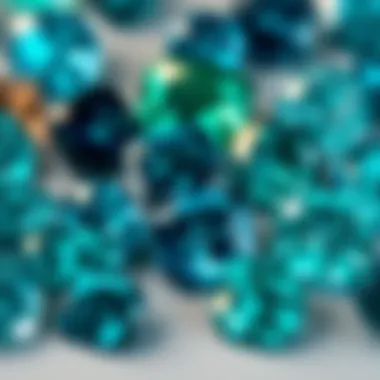
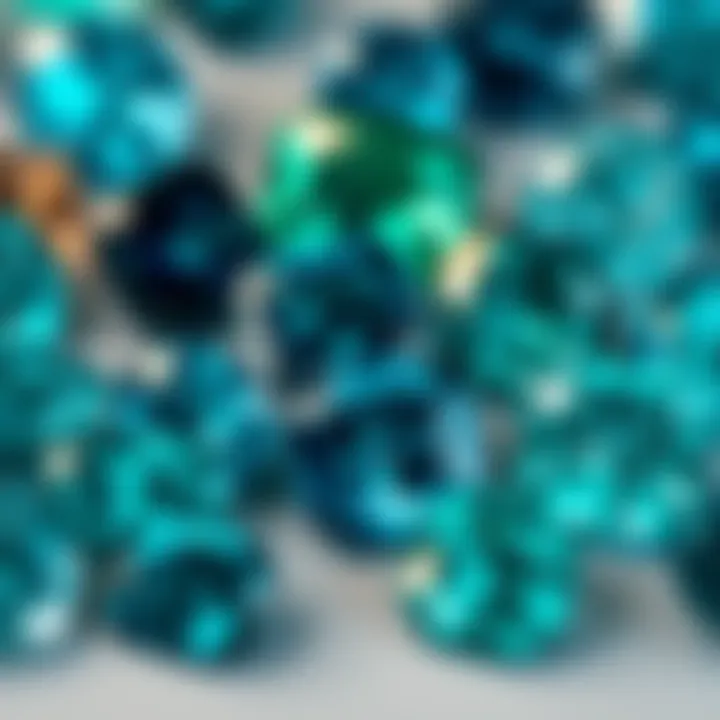
Cleaning and Maintenance
Keeping your teal sapphire clean is a straightforward process, but it requires a gentle touch. Here are some effective cleaning methods:
- Soapy Water: A simple mix of warm water and mild soap works wonders. Use a soft cloth or a brush with gentle bristles to remove dirt and grime. Rinse thoroughly and dry.
- Ultrasonic Cleaners: While these can be effective, caution is advised. Teal sapphires, depending on their clarity and inclusion levels, may not always withstand ultrasonic cleaning. Avoid this method if your sapphire has significant internal flaws.
- Professional Cleaning: When in doubt, seeking help from a professional jeweler can save you from potential mishaps. They have specialized tools and expertise to clean your sapphire safely without causing harm.
"A well-cared-for teal sapphire is worthy of admiration, capturing the light and the hearts of those who lay eyes on it."
Maintaining the brilliance of your gemstone also involves proper handling. Always take care to avoid exposure to harsh chemicals or direct physical impacts. It's wise to slip your jewelry off during activities that might pose a risk, such as sports or gardening.
Storage Recommendations
Storage plays a pivotal role in the longevity of teal sapphires. Choosing the right environment can protect these stones from scratches and environmental degradation. Here are some tips on how to store your teal sapphires:
- Jewelry Box: A lined jewelry box is a safe haven for your sapphires. When storing, wrap each piece in a soft cloth to avoid tangling and scratching against other jewelry.
- Individual Compartments: If possible, store teal sapphires in their own compartments to minimize contact with other stones or metals.
- Avoid Humidity: Keeping your sapphires in a dry location helps to prevent moisture buildup, which could lead to unwanted deterioration over time.
- Temperature Control: Fluctuations in temperature can affect the structure of the stone. Store in a stable environment where temperature changes are minimal.
Proper cleaning and storage ensure that your teal sapphires remain as captivating as when you first acquired them. By adopting these practices, you not only uphold their beauty but also protect your investment, bringing peace of mind that your gems will continue to shine for generations.
Emerging Trends and Future Outlook
In the ever-evolving landscape of the gemstone industry, teal sapphires have found their niche as a captivating choice for consumers. Understanding emerging trends is essential not only for collectors but also for designers looking to stay ahead of the curve. This section delves into the current shifts in consumer preferences and the increasing importance of ethical sourcing. Highlighting these trends paints a clearer picture of the future of teal sapphires.
Changing Consumer Preferences
Today's buyers are not merely looking for stunning gemstones to showcase; they seek stones with a story and a sense of responsibility behind them. The interest in teal sapphires has surged due in part to their unique color and rarity but also because of shifting priorities in consumer behavior.
- Color and Uniqueness: The vibrant, ocean-like color of teal sapphires sets them apart from traditional blue sapphires, making them particularly attractive to younger consumers who often favor unique pieces. Many buyers are leaning towards gemstones that allow for personal expression rather than conformity.
- Sustainability: Environmental considerations have never been more pressing. Consumers are increasingly demanding ethically sourced materials, and teal sapphires fulfil this need. Buyers are often investigating the origins of their gemstones, and brands that can assure ethical sourcing are likely to win loyalty.
- Transparency in Certification: In this digital age, there is an expectation for transparency. Consumers want to know the details of the certification process. Brands that provide this information are gaining a competitive edge.
"Ethical and sustainable choices are now integral to the purchasing decision for many buyers; it’s not just about beauty anymore."
By tapping into these trends, jewelers can create pieces that resonate more strongly with their audiences.
Sourcing Ethical Teal Sapphires
As awareness regarding ethical practices in gemstone sourcing has grown, so has the importance of obtaining teal sapphires responsibly. Ethical sourcing refers to the practices that ensure gemstones are mined without harm to the environment or communities. Here are a few critical elements involved in sourcing ethical teal sapphires:
- Traceable Origins: Many consumers now seek assurances that their teal sapphires are traceable to their mines. This traceability helps ensure that their purchase supports fair labor practices.
- Responsible Mining Practices: Efforts are underway to promote sustainable mining methodologies. This includes minimizing ecological impact and providing fair wages to miners.
- Support for Local Communities: Ethical gem sourcing often ties into community support. When jewelers partner with local miners, they help uplift households and communities that rely on gemstone extraction for their livelihood.
More brands are making commitments to ethically source their teal sapphires, offering transparency and nurturing community relationships that will become increasingly valuable in creating a responsible gemstone market.
In summary, the future of teal sapphires is not just about their stunning beauty but also about the values that accompany their journey from the earth to the consumer’s hands. As preferences continue to shift, those in the gemstone industry who understand and adapt to these changes will pave the way for a more sustainable future.
Finale: The Enduring Allure of Teal Sapphire
The teal sapphire is not just another gem in the world of gemstones; it embodies a blend of beauty, rarity, and significance that resonates deeply with gemstone enthusiasts, collectors, and jewelry designers. Its unique hue, a dance between blue and green, captures the light and the imagination alike, making it a favored choice for those who seek something distinct from traditional sapphires.
The significance of concluding our exploration with a focus on the allure of teal sapphire stems from several critical aspects. Firstly, there is the aspect of cultural impact. Throughout history, teal sapphires have often been illuminated in both royal and personal contexts, symbolizing a love that is deep and tranquil. They have adorned the crowns and wardrobes of royals, illustrating their position not just as adornments but as status symbols that reflect craftsmanship and dedication to beauty.
Furthermore, the commercial landscape surrounding teal sapphires has evolved, presenting both challenges and opportunities. As consumers become more eco-conscious and demand ethically sourced stones, the teal sapphire market has had to adapt. The rising trend in ethical sourcing amplifies the importance of knowing where these stones originate from, which is vital for collectors and current jewelry trends.
Let’s briefly touch upon what truly makes teal sapphires stand out:
- Visual Appeal: The stunning array of colors, from soft aqua to deep teal, attracts a wide range of tastes.
- Versatility: These sapphires work splendidly in various jewelry styles, from casual to formal, allowing wearers to express their individuality.
- Rarity: Unlike their blue counterparts, teal sapphires are rarer, which adds to their desirability and value.
In light of these points, the allure of teal sapphires can be boiled down to their intrinsic beauty, coupled with the stories they carry from their origins to the present day. As our world embraces ethical practices and craftsmanship, teal sapphires hold a unique position as gems that not only please the eye but also resonate with ethical considerations in the gemstone industry.
The exploration concludes but not without leaving a lasting appeal. Whether seen as a cherished piece of art in personal collections, a meaningful gift, or an investment, teal sapphires continuously find their way into the hearts of many. This timeless quality ensures that they will remain a cherished gem in the jewelry landscape for years to come.
"In every teal sapphire lies a story, waiting to be discovered, treasured, and told."
For those interested, further information about this unique gemstone can be found at Wikipedia and Britannica. For collectors and designers, market trends can also be explored on platforms such as Reddit and Facebook groups.







